
Smart Lighting – Lighting Up the Future

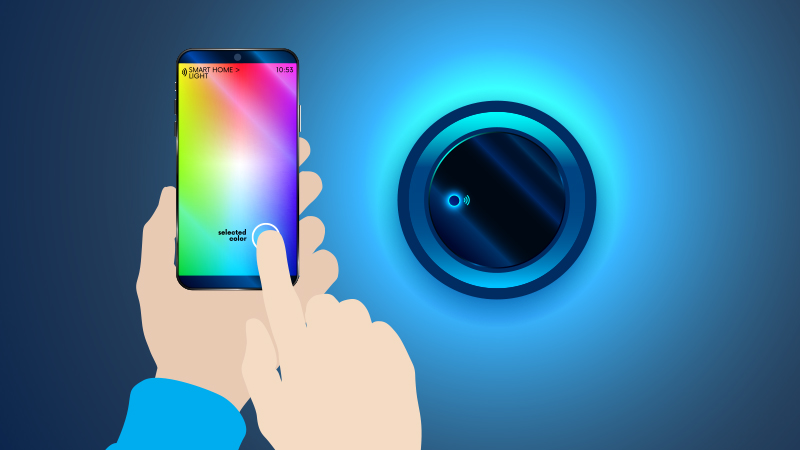
The global lighting market is undergoing a massive transformation, driven by two trends: the increasing adoption of LED technology and usage of connected lighting systems, known as smart lighting. The global lighting market of $133.94 billion is growing steadily, and it is expected to grow at a CAGR of more than 10.4 percent between 2017 and 2025. The general lighting market is expected to grow at a CAGR of 5 percent by 2020 and the smart lighting segment at 22 percent by 2023. The global smart lighting controls market is expected to grow at a CAGR of 21 percent from 2018 to 2024. The global lighting industry is dominated by the Asian market, with a share of 40 percent, followed by the developed markets, namely Europe and North America, with shares of 20 percent and 15 percent, respectively. Global lighting demand in the residential segment is expected to grow at a CAGR of 6.12 percent from 2018–2022.
“Smart Lighting” is the newest stage of evolution in the lighting industry. Owing to the significant benefits it offers, it is steadily advancing towards becoming the norm in residential and commercial lighting.. This technology has been successfully implemented in various regions across sectors such as retail, industrial healthcare, etc. Several lighting firms in the U.S., Europe, China, and various other countries have been actively involved in the implementation of smart lighting in order to increase energy efficiency and overall cost savings.
|
Key Highlights |
|
Introduction - Smart Lighting
- The global smart lighting market is expected to reach $21 billion by 2023, and is expected to grow at a CAGR of 22 percent from 2018 until 2023. The European smart lighting segment is approximately worth $2 billion and is expected to grow at a rate of 20 percent from 2018 to 2024. Wireless technology is expected to drive the growth in the smart lighting sector from 2018 onwards, owing to reduced cost of installation and ease of maintenance post-installation.
- Cloud computing is commonly used in smart lighting systems. Smart lighting has already been adopted in the residential, retail, commercial sectors; whereas new opportunities are emerging in the horticulture, healthcare, and education sectors. North America is the second largest user and held almost 35 percent of the market share for high-end lighting globally in 2017
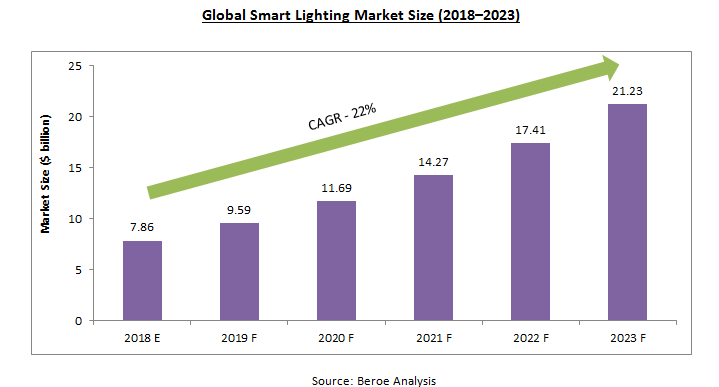
- APAC is the biggest consumer of smart lighting globally, and its consumption is expected to grow at a rate of 8.5 percent between 2017 and 2025. The major growth drivers are increased use of LED lighting, innovations, lighting system upgradations in infrastructures, and increasing awareness among consumers about energy conservation.
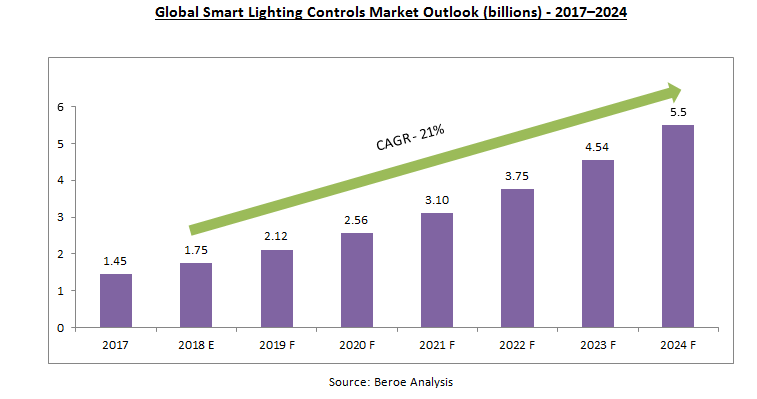
- Traditional lighting control enables users to switch, schedule, tune color, and control lighting requirements. Whereas, the cloud-based lighting control system automatically controls the light usage, depending on the ambience. This system also collects usage data, which helps facility managers control their lighting expenditure.
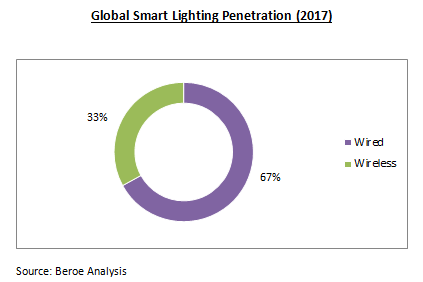
Smart Lighting – Impact on Overall Cost
- Lighting energy: The major share, that is, 77 percent, of the total cost of lighting is taken up by the electricity usage, which helps to run the products.
- HVAC energy: HVAC is mainly used to control temperature variations in light bulbs, which is almost 8 percent of the total cost.
- Labor: 11 percent of the cost is for labor, dedicated to maintenance and replenishment of light bulbs.
- Materials: The cost of replacing the lighting products in the store accounts for 3 percent of the total cost.
- Recycling: Products that have burnt-out comprise 1 percent of the cost.
- The costs mentioned in the break-down for lighting services in retail stores are mostly dependent on external factors, such as the application of new technologies in the manufacturing and functioning of products, quality of products available in the market, and so on.
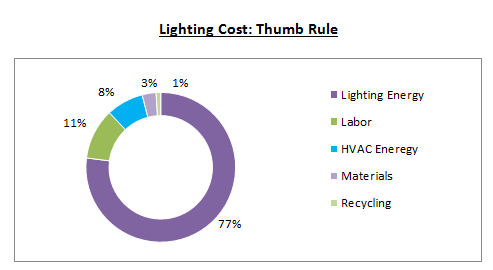
- The actual cost of lighting is also affected by factors such as building type, geographical location, market segments, and so on. However, the application of technologies has resulted in decreased lighting energy and maintenance costs.
- Many global general retailers in North America, such as Wal-Mart, Target, and Costco have adopted advanced cloud-based lighting control systems to reduce energy consumption. Target implemented smart lighting control systems across their stores in the US. They successfully reduced annual energy usage from 26.6 million kilowatt hours to 10.7 million kilowatt hours.
Popular Smart Lighting Technologies
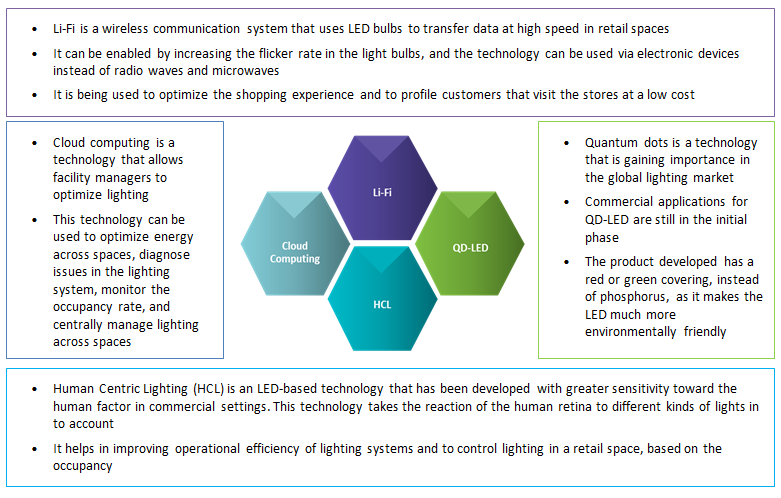
References
https://technology.ihs.com/586788/smart-lighting-and-connected-lighting-controls-market-to-double-by-2020
http://www.globallightingassociation.org/
http://www.archlighting.com/products/leds-and-drivers/led-market-forecast_o
https://energy.gov/sites/prod/files/2016/02/f29/smallwood_mktadoption_raleigh2016.pdf
https://technology.ihs.com/api/binary/520405lighting-trends-in-2016 – HIS
https://www.linkedin.com/pulse/retail-early-adopter-new-technologies-lifi-very-one-van-den-bussche
https://www.digitallumens.com/resources/blog-post/part-2-smart-smart-lighting/
http://www.digikey.com/en/articles/techzone/2012/jul/the-use-of-sensors-in-commercial-lighting-applications
http://technopow.com/index.php/2017/10/04/residential-connected-lighting-market/
http://www.findmarketresearch.org/2017/09/energy-efficient-lighting-market-future-demand-and-growth-analysis-with-forecast-2024/
https://www.prnewswire.com/news-releases/global-intelligent-lighting-controls-market-report-2018-2024---market-value-to-grow-at-a-cagr-of-20-9-volume-at-13-3-300640001.html
http://www.ledjournal.com/main/blogs/global-led-lighting-trends-reveal-significant-growth-and-product-development/
http://www.digitimes.com/news/a20160317PD205.html
http://www.prnewswire.com/news-releases/global-lighting-market-2017-2021-300453696.html
https://www.businesswire.com/news/home/20180427006012/en/Global-General-Lighting-Market-Outlook-2018-2022-Declining
Related Insights:
View All
Get more stories like this
Subscirbe for more news,updates and insights from Beroe






